CHEVROLET TRACKER 1993 Owners Manual
Manufacturer: CHEVROLET, Model Year: 1993, Model line: TRACKER, Model: CHEVROLET TRACKER 1993Pages: 339, PDF Size: 15.75 MB
Page 261 of 339
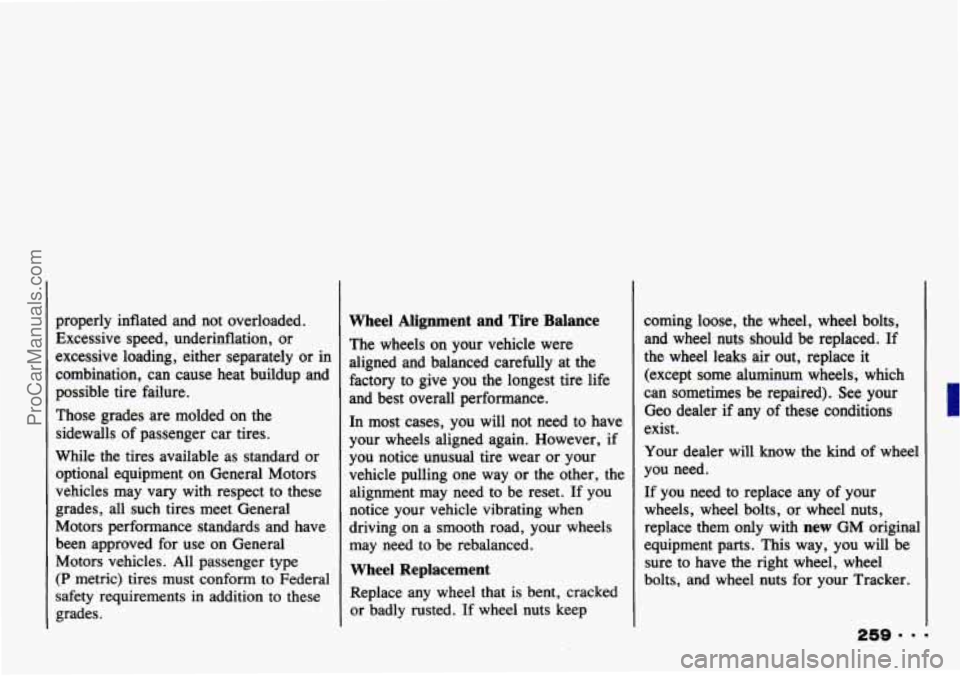
properly inflated and not overloaded.
Excessive speed, underinflation, or
excessive loading, either separately or in
combination, can cause heat buildup and
possible tire failure.
Those grades are molded on the
sidewalls of passenger car tires.
While the tires available as standard or
optional equipment on General Motors
vehicles may vary with respect to these
grades, all such tires meet General
Motors performance standards and have
been approved for use on General
Motors vehicles. All passenger type
(P metric) tires must conform to Federal
safety requirements in addition to these
grades.
Wheel Alignment and Tire Balance
The wheels on your vehicle were
aligned and balanced carefully at the
factory to give you the longest tire life
and best overall performance.
In most cases, you will not need to have
your wheels aligned again. However, if
you notice unusual tire wear
or your
vehicle pulling one way or the other, the
alignment may need to be reset. If you
notice your vehicle vibrating when
driving on a smooth road, your wheels
may need to be rebalanced.
Wheel Replacement
Replace any wheel that is bent, cracked
or badly rusted. If wheel nuts keep coming
loose, the wheel, wheel bolts,
and wheel nuts should be replaced.
If
the wheel leaks air out, replace it
(except some aluminum wheels, which
can sometimes be repaired). See your
Geo dealer if
any of these conditions
exist.
Your dealer will know the kind of wheel
you need.
If you need to replace any of your
wheels, wheel bolts, or wheel nuts,
replace them only with
new GM original
equipment parts. This way, you will be
sure to have the right wheel, wheel
bolts, and wheel nuts for your Tracker.
ProCarManuals.com
Page 262 of 339
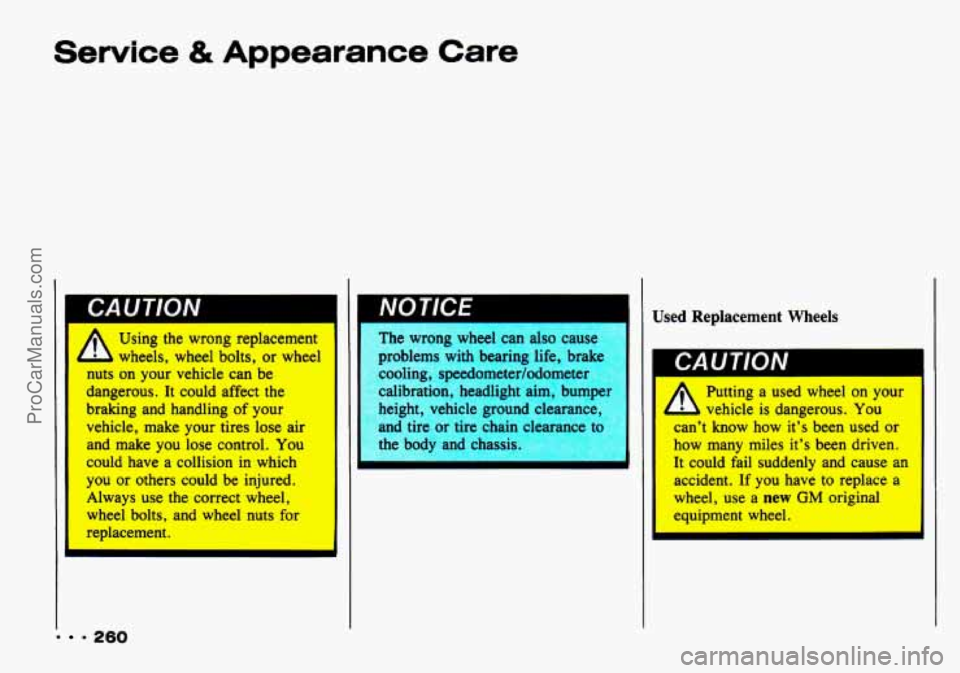
Service & Appearance Care
nuts on your vehicle can be
dangerous. It could affect the
braking and handling of your
vehicle, make your tires lose air
and make you lose control.
You
could have a collision in which
you or others could be injured.
Always use the correct wheel,
wheel bolts, and wheel nuts for
replacement.
NOTlCE
= 260
The wrong wheel can also cause
problems with bearing life, brakc
cooling, speedometer/odometer
calibration, headlight aim, bump
height, vehicle ground cleara
and tire or tire chain clearance
tc
the body and chassis Used
Replacement Wheels
I
Ab
Putting a used wheel on your
vehicle is dangerous. You
can’t
know how it’s been used or
how many miles it’s been driven.
It could fail suddenly and
cause an
accident. If you have to replace a
wheel, use a new GM original
equipment wheel.
ProCarManuals.com
Page 263 of 339

NOTICE Appearance Care
Pleaning products can be hazardous. Some are toxic. Others can burst I
- ,,,,o flame if you strike a match or get them on a hot part of the vehicle.
~ ome are dangerous if you breathe their fumes in a closed space. When you
use anything in a container to clean your Geo, be sure to
follow the
instructions. And always open your doors or windows when you're cleaning
the inside.
Never use these to clean your vehicle:
Gasoline Carbon Tetrachloride Turpentine
Benzene Acetone Lacquer Thinner
Naphtha Paint Thinner Nail Polish Remover
They can all be hazardous
- some more than others - and they can all
damage your vehicle, too.
I-
ProCarManuals.com
Page 264 of 339

Service & Appearance Care
NO TIC€
Don't use any of these unless thi
manual says you can. In
monv
uses, thev will damage vnl
vehiclc
Laundrv Soan
Blec-'-
Reauc: gents
Cleaning the lnside of Your Geo
Use a vacuum cleaner often to get rid of
dust and loose dirt. Wipe
vinyl with a
clean, damp cloth.
Your Geo dealer has two GM cleaners
- a solvent-type spot lifter and a
Foam-type powdered cleaner. They will
:lean normal spots and stains very well.
Here are some cleaning tips:
Always read the instructions on the
Clean up stains as soon as you can -
cleaner label.
before
they set.
Use a clean cloth or sponge, and
change to a clean area often.
A soft
brush may be used if stains are
stubborn.
Use solvent-type cleaners in a well
ventilated area only.
If you use them,
don't saturate the stained area.
clean the entire area immediately or
it
will set.
If a ring forms after spot cleaning,
262
ProCarManuals.com
Page 265 of 339
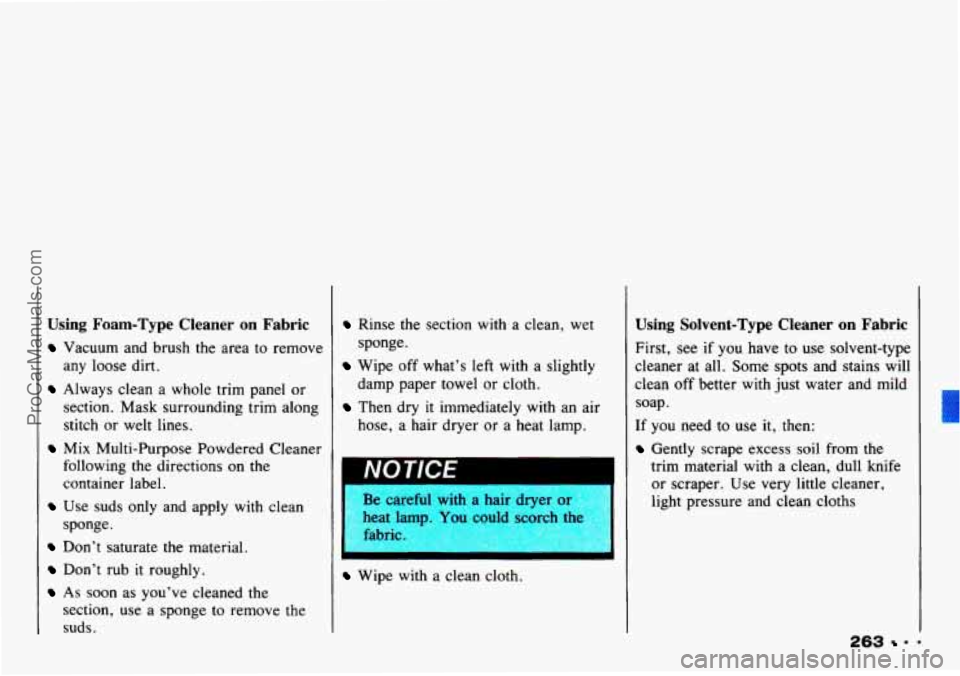
Using Foam-Type Cleaner on Fabric
Vacuum and brush the area to remove
Always clean a whole trim panel or
any
loose dirt.
section. Mask surrounding trim along
stitch or welt lines.
Mix Multi-Purpose Powdered Cleaner
following
the directions on the
container label.
Use suds only and apply with clean
Don’t saturate the material.
Don’t rub it roughly.
As soon as you’ve cleaned the
sponge.
section,
use a sponge to remove
the
suds.
Rinse the section with a clean, wet
sponge.
Wipe off what’s left with a slightly
damp paper towel or cloth.
Then dry it immediately with an air
hose, a hair dryer or a heat lamp.
Be careful with a nalr aryer or
heat lamp. You could scorch thl
Wipe with a clean cloth. Using
Solvent-Type Cleaner on
Fabric
First, see if you have to use solvent-type
cleaner at all. Some spots and stains will
clean off better with
just water and mild
soap.
If you need to use it, then:
Gently scrape excess soil from the
trim material with a clean, dull knife
or scraper. Use very little cleaner,
light pressure and clean cloths
263 - -
ProCarManuals.com
Page 266 of 339
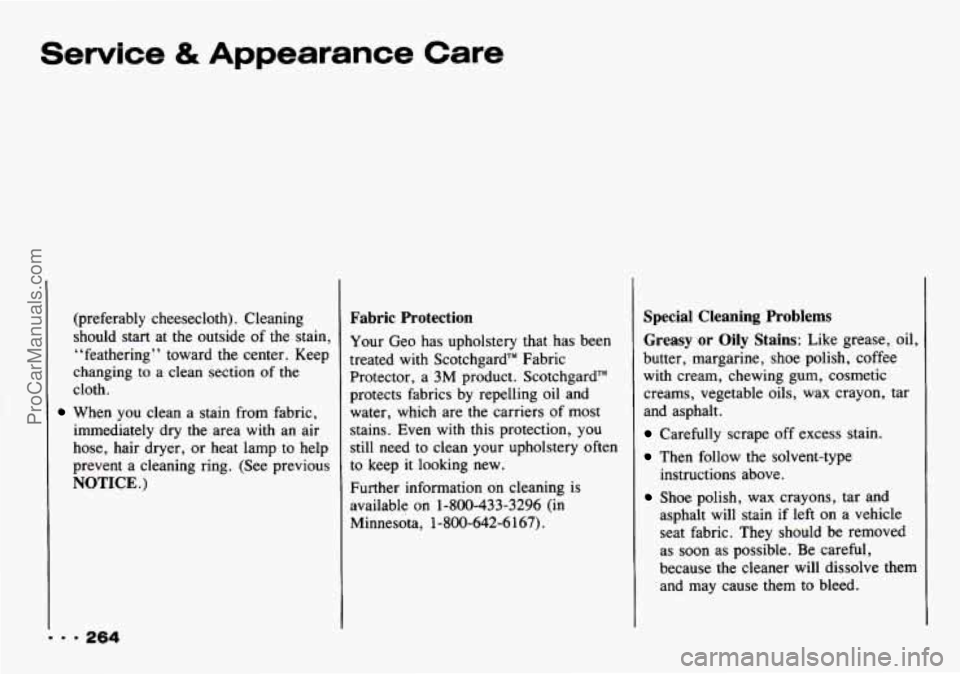
Service & Appearance Care
I.. 264
(preferably cheesecloth). Cleaning should
start at the outside of the stain,
“feathering” toward the center. Keep
changing to a clean section of
the
cloth.
When you clean a stain from fabric,
immediately dry
the area with an air
hose, hair dryer, or heat lamp to help
prevent a cleaning ring. (See previous
NOTICE .)
Fabric Protection
Your Geo has upholstery that has been
treated
with Scotchgard’” Fabric
Protector, a
3M product. Scotchgard“
protects fabrics by repelling oil and
water, which are the carriers of most
stains. Even with this protection, you
still need to clean your upholstery often
to keep it looking new.
Further information on cleaning is
available on
1-800-433-3296 (in
Minnesota, 1-800-642-6 167).
Special Cleaning Problems
Greasy
or Oily Stains: Like grease, oil,
butter, margarine, shoe polish, coffee
with cream, chewing gum, cosmetic
creams, vegetable oils, wax crayon, tar
and asphalt.
Carefully scrape off excess stain.
Then follow the solvent-type
Shoe polish, wax crayons, tar and
instructions above.
asphalt will stain if left on a vehicle
seat fabric. They should be removed
as soon as possible. Be careful,
because the cleaner will dissolve them
and may cause them to bleed.
ProCarManuals.com
Page 267 of 339
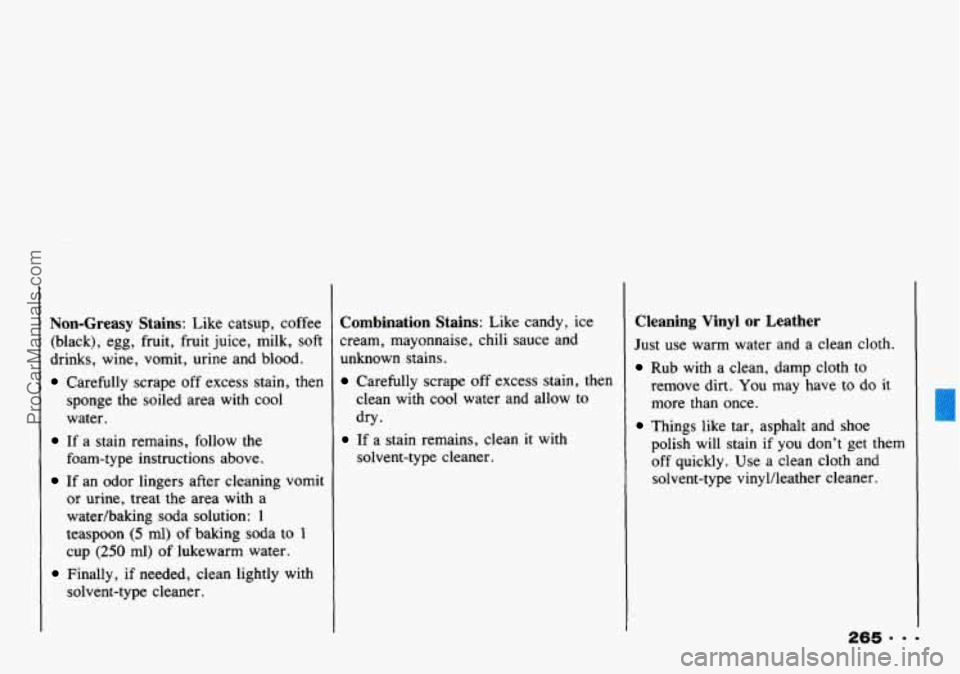
Non-Greasy Stains: Like catsup, coffee
(black), egg, fruit, fruit juice, milk,
soft
drinks, wine, vomit, urine and blood.
Carefully scrape off excess stain, then
sponge the soiled area with
cool
water.
If a stain remains, follow the
foam-type instructions above.
If an odor lingers after cleaning vomit
or urine, treat the area with
a
watedbaking soda solution: 1
teaspoon (5 ml) of baking soda to 1
cup (250 ml) of lukewarm water.
Finally, if needed, clean lightly with
solvent-type cleaner.
I
Combination Stains: Like candy, ice
cream, mayonnaise, chili sauce and
unknown stains.
Carefully scrape off excess stain, then
clean with cool water and allow to
dry.
solvent-type cleaner.
If a stain remains, clean it with
Cleaning Vinyl or Leather
Just use warm water and a clean cloth.
Rub with a clean, damp cloth to
remove dirt. You may have to do it
more than once.
polish will stain if you don’t get them
off quickly. Use a clean cloth and
solvent-type vinyl/leather cleaner.
Things like tar, asphalt and shoe
ProCarManuals.com
Page 268 of 339

Service & Appearance Care
Cleaning the Top of the Instrument
Panel
Use only mild soap and water to clean
the top surfaces of the instrument panel.
Sprays containing silicones or waxes
may cause annoying reflections in the
windshield and even make it difficult to
see through the windshield under certain
conditions.
Care of Safety Belts
Keep belts clean and dry.
CAUTIVN
Do not bleach or dye safety
belts.
If you do, it may
severely weaken them. In a crash
they might not be able to provide
adequate protection. Clean safety
belts
only with mild soap and
lukewarm water.
Glass
Glass should be cleaned often. GM
Glass Cleaner (GM Part No. 1050427)
or a liquid household glass cleaner will
remove normal tobacco smoke and dust
films.
Don’t use abrasive cleaners on glass,
because they may cause scratches.
Avoid placing decals on the inside rear
window, since they may have to be
scraped
off later. If abrasive cleaners
are used on the inside of the rear
window, an electric defogger element
may be damaged.
Any temporary license
should not be attached across the
defogger grid.
ProCarManuals.com
Page 269 of 339

Cleaning the Outside of the
Windshield and Wiper Blades
If your windshield is not clear after
using the windshield washer, or
if the
wiper blade chatters when running, wax
or other material may be on the blade or
windshield.
Clean the windshield with
GM
Windshield Cleaner Bon-Ami Powder@
(GM Part No. 1050011). The windshield
is clean
if beads do not form when you
rinse
it with water.
Clean the blade by wiping vigorously
with a cloth soaked in full strength
windshield washer solvent. Then rinse
the blade with water.
Wiper blades should be checked on a
regular basis and replaced when worn.
Cleaning the Outside of Your
Geo
The paint finish on your vehicle
provides beauty, depth of color, gloss
retention and durability.
Washing Your Vehicle
The best way to preserve your vehicle’s
finish
is to keep it clean by washing it
often with lukewarm or cold water.
Don’t wash your vehicle
in the direct
rays of the sun. Don’t use strong soaps
or chemical detergents. Use liquid hand,
dish or car washing (non-detergent)
soaps. Don’t use cleaning agents that
contain acid or abrasives. All cleaning
agents should be flushed promptly and
not allowed to dry on the surface, or they could
stain. Dry the finish with a
soft, clean chamois or a
100% cotton
towel to avoid surface scratches and
water spotting.
High pressure car washes may cause
water to enter your vehicle.
Finish Care
Occasional waxing or mild polishing of
your
Geo may be necessary to remove
residue from the paint finish.
You can
get GM approved cleaning products
from your dealer. (See “Appearance
Care and Materials”
in the Index.)
Your Geo has a “basecoat/clearcoat”
paint finish. The clearcoat gives more
depth and
gloss to the colored basecoat.
267 = -
ProCarManuals.com
Page 270 of 339
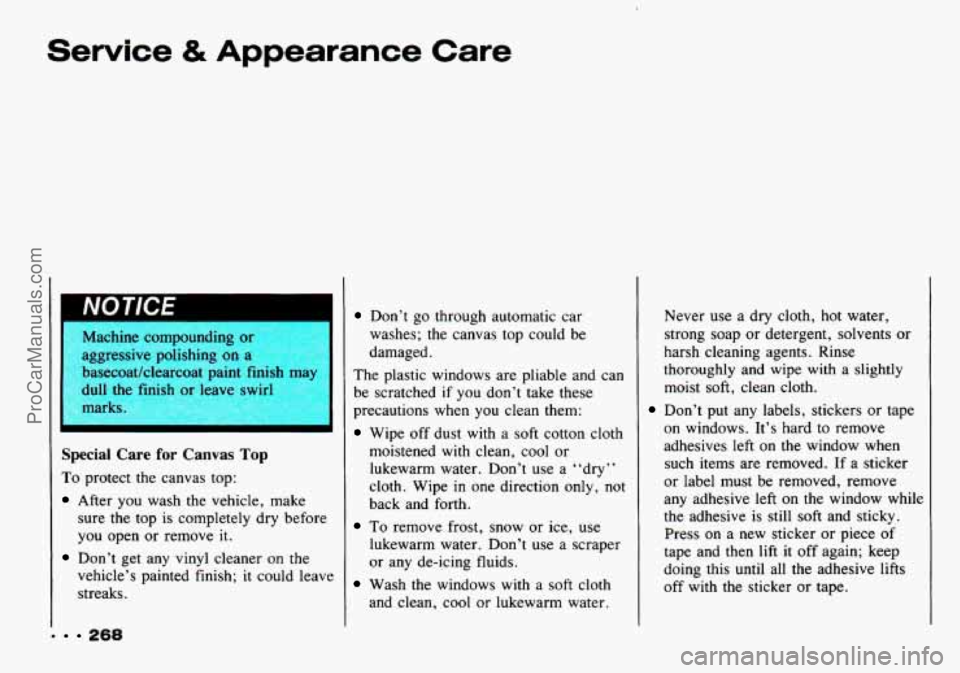
Service & Appearance Care
268
Machine compounding or
aggressive polishing on a
basecoat/clearcoat paint finish
IT
dull tl sh or lea sw’ ’
marks
Special Care for Canvas Top
To protect the canvas top:
After you wash the vehicle, make
sure the top is completely dry before
you open or remove
it.
Don’t get any vinyl cleaner on the
vehicle’s painted finish; it could leave
streaks.
Don’t go through automatic car
washes;
the canvas top could be
damaged.
The plastic windows are pliable and can
be scratched
if you don’t take these
precautions when you clean them:
Wipe off dust with a soft cotton cloth
moistened
with clean, cool or
lukewarm water. Don’t use a “dry”
cloth. Wipe
in one direction only, not
back and forth.
To remove frost, snow or ice, use
lukewarm water. Don’t use a scraper
or any de-icing fluids.
Wash the windows with a soft cloth
and clean, cool or lukewarm water. Never
use a dry cloth, hot water,
strong soap or detergent, solvents or
harsh cleaning agents. Rinse
thoroughly and wipe with a slightly
moist
soft, clean cloth.
Don’t put any labels, stickers or tape
on windows. It’s hard to remove
adhesives left on the window when such items are removed. If a sticker
or label must be removed, remove
any adhesive
left on the window while
the adhesive is still soft and sticky.
Press
on a new sticker or piece of
tape and then lift it off again; keep
doing this until all the adhesive lifts
off with the sticker or tape.
ProCarManuals.com